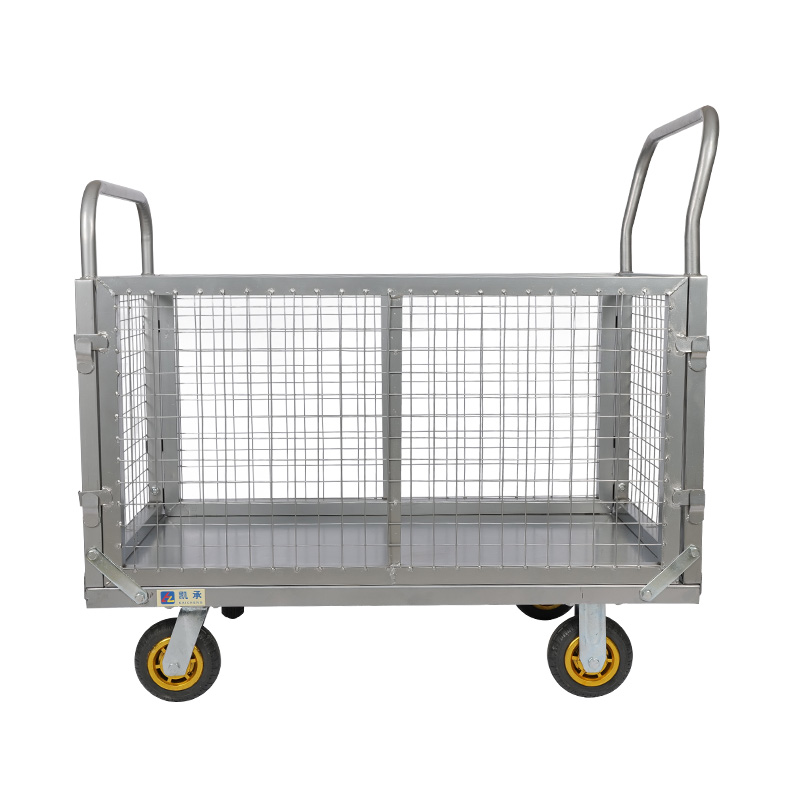Designing a Metal Foldable Trolley to ensure its stability under high loads or complex terrain requires comprehensive consideration of material selection, structural design, manufacturing process, and usage environment. The following are detailed design principles and methods:
Select high-strength and lightweight materials
High-strength metal: Use high-strength steel (such as carbon steel or alloy steel) or aluminum alloy as the main frame material to ensure that it can withstand high loads without deformation.
Advantages: These materials have excellent mechanical strength and fatigue resistance.
Lightweight design: Minimize material weight while ensuring strength, such as using hollow tubes or composite materials (such as carbon fiber reinforced aluminum) to improve portability and ease of operation.
Corrosion-resistant coating: To prevent rust problems during long-term use, metal parts are treated with anti-corrosion treatment (such as galvanizing, painting, or anodizing).
Optimize geometric structure
Reinforcement design: Add reinforcement ribs or ribs to key stress-bearing parts (such as the bottom frame and support legs) to improve overall rigidity and bending resistance.
Wide base design: By increasing the bottom width and contact area, the center of gravity is lowered and the stability is improved, especially on complex terrain.
Modular design: The trolley is divided into multiple detachable modules to facilitate the replacement of damaged parts while reducing maintenance costs.
Strengthened connection and fixing methods
Firm connection: Use high-strength bolts, welding or other reliable methods to fix the components together to prevent loosening or falling off.
Anti-loosening design: In a vibrating environment, measures such as double nuts, spring washers or chemical anti-loosening glue are used to ensure the stability of the connection parts.

Folding mechanism optimization: Design a reliable folding locking device to ensure that the trolley will not fold accidentally when unfolded.
Improve wheel performance
Large diameter wheels: Choose larger diameter wheels to adapt to complex terrain (such as grass, sand or rocky roads) and reduce rolling resistance.
Solid tires or pneumatic tires:
Solid tires: Suitable for heavy loads and wear-resistant needs, avoiding the risk of puncture.
Pneumatic tires: Provide better shock absorption and suitable for uneven ground.
Combination of universal wheels and fixed wheels: universal wheels are used on the front wheels to improve flexibility, and fixed wheels are used on the rear wheels to enhance stability.
Control the distribution of the center of gravity
Low center of gravity design: By rationally arranging the cargo carrying area, ensure that the center of gravity is as close to the ground as possible, thereby improving stability.
Adjustable pallet: Design pallets or shelves with adjustable heights to adjust the center of gravity according to the weight of the cargo.
Enhance impact resistance and fatigue resistance
Buffer device: Add elastic buffers to the axle or handle to absorb the impact force during driving.
Dynamic balance: Through precise processing and assembly, ensure that the trolley maintains a good dynamic balance during movement and reduce instability caused by vibration.
Improve handle design
Ergonomic handle: Design an ergonomic handle shape to reduce the user's hand fatigue.
Retractable handle: Provide a handle with adjustable length to meet the needs of users of different heights.
Anti-slip material: Add anti-slip material (such as rubber or silicone) to the handle surface to improve grip comfort and safety.
Designing a metal folding trolley to ensure its stability under high load or complex terrain conditions requires comprehensive consideration of multiple aspects such as material selection, structural optimization, manufacturing process and environmental adaptability. The stability and reliability of the trolley can be significantly improved by selecting high-strength materials, optimizing geometric structures, strengthening connection methods and improving wheel performance. In addition, with the advancement of technology, the addition of intelligent functions will further enhance the user experience and meet diverse needs.


 English
English Español
Español



